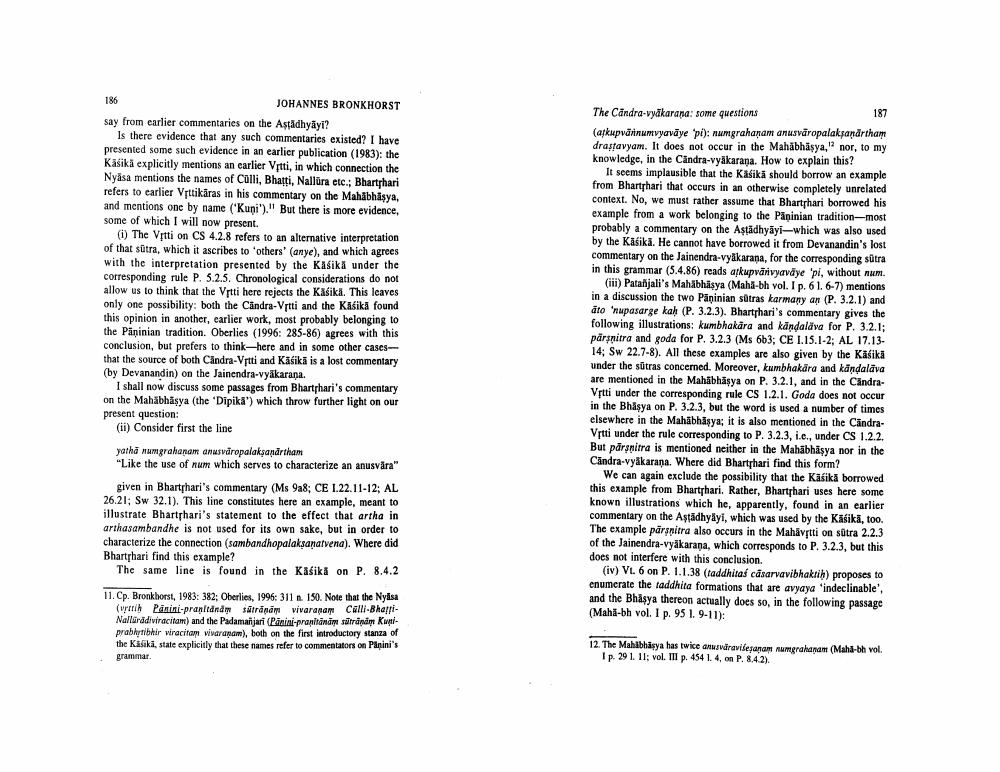Book Title: Candra Vyakarna Some Questions Author(s): Johannes Bronkhorst Publisher: Johannes Bronkhorst View full book textPage 3
________________ 185 187 JOHANNES BRONKHORST say from earlier commentaries on the Astādhyāyi? Is there evidence that any such commentaries existed? I have presented some such evidence in an earlier publication (1983): the Käsika explicitly mentions an earlier Vrtti, in which connection the Nyasa mentions the names of Culli, Bhatti, Nallura etc.: Bharthari refers to earlier Vrttikäras in his commentary on the Mahabhasya, and mentions onc by name ("Kuni')." But there is more evidence, some of which I will now present. (1) The Vrtti on CS 4.2.8 refers to an alternative interpretation of that sutra, which it ascribes to others' (anye), and which agrees with the interpretation presented by the Kašika under the corresponding rule P. 5.2.5. Chronological considerations do not allow us to think that the Vrtti here rejects the Kašika. This leaves only one possibility: both the Candra-Vrtti and the Kasika found this opinion in another, carlier work, most probably belonging to the Påninian tradition. Oberlies (1996: 285-86) agrees with this conclusion, but prefers to think here and in some other casesthat the source of both Candra-Vrtti and Kašikā is a lost commentary (by Devanandin) on the Jainendra-vyäkarana. I shall now discuss some passages from Bharthari's commentary on the Mahabhäsya (the 'Dipika") which throw further light on our present question: (ii) Consider first the line The Candra-vyākarana: some questions (arkupninumvyavāye 'pi): numgrahanam arus dropalakpandrtham drastavyam. It does not occur in the Mahabhäsya," nor, to my knowledge, in the Candra-vyakarana. How to explain this? It seems implausible that the Kašikä should borrow an example from Bharthari that occurs in an otherwise completely unrelated context. No, we must rather assume that Bharthari borrowed his example from a work belonging to the Papinian tradition-most probably a commentary on the Astādhyāyi-which was also used by the Kasika. He cannot have borrowed it from Devanandin's lost commentary on the Jainendra-vyåkarana, for the corresponding sutra in this grammar (5.4.86) reads arkupvärivaväye 'pi, without num. (iii) Patanjali's Mahabhäsya (Maha-bh vol. I p. 61. 6-7) mentions in a discussion the two Paninian stras karmany an (P. 3.2.1) and ato nupasarge kah (P. 3.2.3). Bharthari's commentary gives the following illustrations: kumbhakara and kandalava for P. 3.2.1; pärinitra and goda for P. 3.2.3 (Ms 6b3; CE 1.15.1-2; AL 17.1314: Sw 22.7-8). All these examples are also given by the Kasika under the sutras concerned. Moreover, kumbhakara and kändalava are mentioned in the Mahabhāsya on P. 3.2.1, and in the CandraVrtti under the corresponding rule CS 1.2.1. Goda does not occur in the Bhäsya on P. 3.2.3, but the word is used a number of times elsewhere in the Mahabhasya; it is also mentioned in the CandraVrtti under the rule corresponding to P. 3.2.3, i.c., under CS 1.2.2. But pārsnitra is mentioned neither in the Mahābhāsya nor in the Candra-vyakarana. Where did Bharthari find this form? We can again exclude the possibility that the Kāśikā borrowed this example from Bharthari. Rather, Bharthari uses here some known illustrations which he, apparently, found in an earlier commentary on the Aştādhyayi, which was used by the Käsikā, too. The example pārsnitra also occurs in the Mahävytti on sütra 2.2.3 of the Jainendra-vyakarana, which corresponds to P. 3.2.3. but this does not interfere with this conclusion. (iv) VL. 6 on P. 1.1.38 (taddhitas casarvavibhakti) proposes to enumerate the faddhita formations that are avyaya 'indeclinable'. and the Bhasya thereon actually does so, in the following passage (Mahl-bh vol. I p. 95 1. 9-11): yatha numgrahanam anus dropalaksanartham "Like the use of num which serves to characterize an anusvira" given in Bharthari's commentary (Ms 9a8; CE 1.22.11-12: AL 26.21; Sw 32.1). This line constitutes here an example, meant to illustrate Bharthari's statement to the effect that artha in arthasambandhe is not used for its own sake, but in order to characterize the connection (sambandhopalaksanalvena). Where did Bharthari find this example? The same line is found in the Kasika on P. 8.4.2 11. Cp. Bronkhorst, 1983: 382; Oberlies, 1995: 311 n. 150. Note that the Nyasa (vrti Panini-pranitnim stranam vivaranam Call-BharriNallarddiviracitam) and the Padamañjari (Panini-praplanam sätrapam Kw prablyihir wiracitam waragam), both on the first introductory stanza of the Kaski, state explicitly that these names refer to commentators on Plini's grammar. 12 The Mahabhasya has twice a dravidesnom ugrahanam (Mahl-bh vol. I p. 291. 11; vol m p. 454 L 4. on P. 8.4.2).Page Navigation
1 2 3 4 5 6 7 8 9 10
